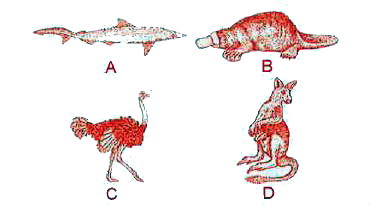A viviparous fish is
Labeo
Clarias
Gambusia
Exocoetus
The correct Answer is:C
To determine which of the given options is a viviparous fish, we need to analyze each option based on their reproductive methods. Viviparous organisms give birth to live young, while oviparous organisms lay eggs.
1. Understand the Terms:
- Viviparous: Organisms that give birth to live young.
- Oviparous: Organisms that lay eggs.
2. Analyze the Options:
- Option A: Labio (Rohu Fish):
- The labio, commonly known as rohu, is a type of carp fish.
- It is oviparous, meaning it lays eggs.
- Conclusion: Incorrect option.
- Option B: Clarias (Catfish):
- Clarias, also known as freshwater catfish, is another fish species.
- It is also oviparous, meaning it lays eggs.
- Conclusion: Incorrect option.
- Option C: Gambusia (Mosquito Fish):
- Gambusia is commonly referred to as mosquito fish.
- It is viviparous, meaning it gives birth to live young.
- Conclusion: Correct option.
- Option D: Exocetus (Flying Fish):
- Exocetus, known as flying fish, is another species.
- It is oviparous, meaning it lays eggs.
- Conclusion: Incorrect option.
3. Final Conclusion:
- The only fish among the options that is viviparous is Gambusia (Option C).
Final Answer:
A viviparous fish is Gambusia (Option C).
---
- Viviparous: Organisms that give birth to live young.
- Oviparous: Organisms that lay eggs.
- Option A: Labio (Rohu Fish):
- The labio, commonly known as rohu, is a type of carp fish.
- It is oviparous, meaning it lays eggs.
- Conclusion: Incorrect option.
- Clarias, also known as freshwater catfish, is another fish species.
- It is also oviparous, meaning it lays eggs.
- Conclusion: Incorrect option.
- Gambusia is commonly referred to as mosquito fish.
- It is viviparous, meaning it gives birth to live young.
- Conclusion: Correct option.
- Exocetus, known as flying fish, is another species.
- It is oviparous, meaning it lays eggs.
- Conclusion: Incorrect option.
- The only fish among the options that is viviparous is Gambusia (Option C).
A viviparous fish is Gambusia (Option C).
Topper's Solved these Questions
- BOOK - DINESH PUBLICATION ENGLISHCHAPTER - VERTEBRATA-AGNATHA AND PISCESEXERCISE - Check Your Grasp12videos
VERTEBRATA-AGNATHA AND PISCES
- BOOK - DINESH PUBLICATION ENGLISHCHAPTER - VERTEBRATA-AGNATHA AND PISCESEXERCISE - Check Your Grasp12videos
VERTEBRATA-AGNATHA AND PISCES
- BOOK - DINESH PUBLICATION ENGLISHCHAPTER - TRANSPORT IN PLANTSEXERCISE - CHECK YOUR GRASP40videos
TRANSPORT IN PLANTS
- BOOK - DINESH PUBLICATION ENGLISHCHAPTER - VIRUSES VIROIDS AND PRIONSEXERCISE - CYG13videos
VIRUSES VIROIDS AND PRIONS
Similar Questions
Knowledge Check
- Question 1 - Select One
Select the option which shows viviparous animals only.
ALizard, TurtleBPlatypus, CrocodileCCow, CrocodileDWhale, Mouse
Cray fish is
View SolutionLargest fish is
View SolutionGive an example for each of the following
A viviparous animal
(b) A fish possessing a poison sting
(c ) A fish possessing an electric organ
(d) An organ, which regulates buoyancy
(e) Animal, which exhibits alternation of generation
(f) Oviparous animal with mammary of glandView SolutionWhich of the following is a viviparous Aschelminth?
View SolutionIdentify viviparous animals (s) from the figures given below .
 View Solution
View SolutionWhich of the following options has examples of viviparous animals only ?
View SolutionA larvaevorous fish is
View Solution

